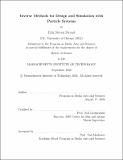| dc.contributor.advisor | Neil Gershenfeld. | en_US |
| dc.contributor.author | Strand, Erik Steven. | en_US |
| dc.contributor.other | Program in Media Arts and Sciences (Massachusetts Institute of Technology) | en_US |
| dc.date.accessioned | 2021-01-06T20:44:11Z | |
| dc.date.available | 2021-01-06T20:44:11Z | |
| dc.date.copyright | 2020 | en_US |
| dc.date.issued | 2020 | en_US |
| dc.identifier.uri | https://hdl.handle.net/1721.1/129322 | |
| dc.description | Thesis: S.M., Massachusetts Institute of Technology, School of Architecture and Planning, Program in Media Arts and Sciences, September, 2020 | en_US |
| dc.description | Cataloged from student-submitted PDF version of thesis. | en_US |
| dc.description | Includes bibliographical references (pages 93-100). | en_US |
| dc.description.abstract | Over the last several decades, computer aided design (CAD) and numeric simulation software have become ubiquitous in engineering research and practice. Despite this, tools that close the loop between design and simulation -- such as optimizing a design based on simulated performance, or searching over simulation parameters to identify where a design functions as intended -- remain highly specialized and relatively underutilized. This thesis charts a path to greater adoption of inverse methods over physical simulation. I demonstrate a portable, high performance simulation tool based on dynamic mesh free particle systems, as well as a generic framework for implementing algorithmically modifiable design languages. I discuss best practices in the use of optimization algorithms and the development of objective functions for simulation based inverse methods. Finally, I present two applications made possible by these tools: optimization of gear tooth profiles, and automated construction of coarse grained models for simulation of plastic deformation of polymers. | en_US |
| dc.description.statementofresponsibility | by Erik Steven Strand. | en_US |
| dc.format.extent | 100 pages | en_US |
| dc.language.iso | eng | en_US |
| dc.publisher | Massachusetts Institute of Technology | en_US |
| dc.rights | MIT theses may be protected by copyright. Please reuse MIT thesis content according to the MIT Libraries Permissions Policy, which is available through the URL provided. | en_US |
| dc.rights.uri | http://dspace.mit.edu/handle/1721.1/7582 | en_US |
| dc.subject | Program in Media Arts and Sciences | en_US |
| dc.title | Inverse methods for design and simulation with particle systems | en_US |
| dc.type | Thesis | en_US |
| dc.description.degree | S.M. | en_US |
| dc.contributor.department | Program in Media Arts and Sciences (Massachusetts Institute of Technology) | en_US |
| dc.identifier.oclc | 1227278365 | en_US |
| dc.description.collection | S.M. Massachusetts Institute of Technology, School of Architecture and Planning, Program in Media Arts and Sciences | en_US |
| dspace.imported | 2021-01-06T20:44:10Z | en_US |
| mit.thesis.degree | Master | en_US |
| mit.thesis.department | Media | en_US |
